Yanfang Ye
Semantic Refinement with LLMs for Graph Representations
Dec 24, 2025Abstract:Graph-structured data exhibit substantial heterogeneity in where their predictive signals originate: in some domains, node-level semantics dominate, while in others, structural patterns play a central role. This structure-semantics heterogeneity implies that no graph learning model with a fixed inductive bias can generalize optimally across diverse graph domains. However, most existing methods address this challenge from the model side by incrementally injecting new inductive biases, which remains fundamentally limited given the open-ended diversity of real-world graphs. In this work, we take a data-centric perspective and treat node semantics as a task-adaptive variable. We propose a Data-Adaptive Semantic Refinement framework DAS for graph representation learning, which couples a fixed graph neural network (GNN) and a large language model (LLM) in a closed feedback loop. The GNN provides implicit supervisory signals to guide the semantic refinement of LLM, and the refined semantics are fed back to update the same graph learner. We evaluate our approach on both text-rich and text-free graphs. Results show consistent improvements on structure-dominated graphs while remaining competitive on semantics-rich graphs, demonstrating the effectiveness of data-centric semantic adaptation under structure-semantics heterogeneity.
BLURR: A Boosted Low-Resource Inference for Vision-Language-Action Models
Dec 12, 2025Abstract:Vision-language-action (VLA) models enable impressive zero shot manipulation, but their inference stacks are often too heavy for responsive web demos or high frequency robot control on commodity GPUs. We present BLURR, a lightweight inference wrapper that can be plugged into existing VLA controllers without retraining or changing model checkpoints. Instantiated on the pi-zero VLA controller, BLURR keeps the original observation interfaces and accelerates control by combining an instruction prefix key value cache, mixed precision execution, and a single step rollout schedule that reduces per step computation. In our SimplerEnv based evaluation, BLURR maintains task success rates comparable to the original controller while significantly lowering effective FLOPs and wall clock latency. We also build an interactive web demo that allows users to switch between controllers and toggle inference options in real time while watching manipulation episodes. This highlights BLURR as a practical approach for deploying modern VLA policies under tight compute budgets.
3D4D: An Interactive, Editable, 4D World Model via 3D Video Generation
Nov 11, 2025Abstract:We introduce 3D4D, an interactive 4D visualization framework that integrates WebGL with Supersplat rendering. It transforms static images and text into coherent 4D scenes through four core modules and employs a foveated rendering strategy for efficient, real-time multi-modal interaction. This framework enables adaptive, user-driven exploration of complex 4D environments. The project page and code are available at https://yunhonghe1021.github.io/NOVA/.
Graph Prompting for Graph Learning Models: Recent Advances and Future Directions
Jun 10, 2025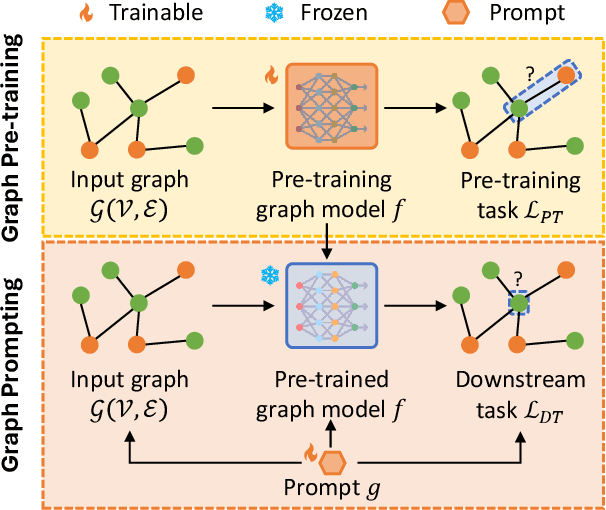
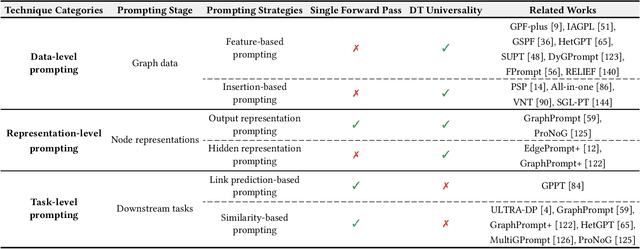

Abstract:Graph learning models have demonstrated great prowess in learning expressive representations from large-scale graph data in a wide variety of real-world scenarios. As a prevalent strategy for training powerful graph learning models, the "pre-training, adaptation" scheme first pre-trains graph learning models on unlabeled graph data in a self-supervised manner and then adapts them to specific downstream tasks. During the adaptation phase, graph prompting emerges as a promising approach that learns trainable prompts while keeping the pre-trained graph learning models unchanged. In this paper, we present a systematic review of recent advancements in graph prompting. First, we introduce representative graph pre-training methods that serve as the foundation step of graph prompting. Next, we review mainstream techniques in graph prompting and elaborate on how they design learnable prompts for graph prompting. Furthermore, we summarize the real-world applications of graph prompting from different domains. Finally, we discuss several open challenges in existing studies with promising future directions in this field.
Scalable Graph Generative Modeling via Substructure Sequences
May 22, 2025Abstract:Graph neural networks (GNNs) has been predominantly driven by message-passing, where node representations are iteratively updated via local neighborhood aggregation. Despite their success, message-passing suffers from fundamental limitations -- including constrained expressiveness, over-smoothing, over-squashing, and limited capacity to model long-range dependencies. These issues hinder scalability: increasing data size or model size often fails to yield improved performance, limiting the viability of GNNs as backbones for graph foundation models. In this work, we explore pathways beyond message-passing and introduce Generative Graph Pattern Machine (G$^2$PM), a generative Transformer pre-training framework for graphs. G$^2$PM represents graph instances (nodes, edges, or entire graphs) as sequences of substructures, and employs generative pre-training over the sequences to learn generalizable, transferable representations. Empirically, G$^2$PM demonstrates strong scalability: on the ogbn-arxiv benchmark, it continues to improve with model sizes up to 60M parameters, outperforming prior generative approaches that plateau at significantly smaller scales (e.g., 3M). In addition, we systematically analyze the model design space, highlighting key architectural choices that contribute to its scalability and generalization. Across diverse tasks -- including node classification, graph classification, and transfer learning -- G$^2$PM consistently outperforms strong baselines, establishing a compelling foundation for scalable graph learning. The code and dataset are available at https://github.com/Zehong-Wang/G2PM.
Graph Foundation Models: A Comprehensive Survey
May 21, 2025Abstract:Graph-structured data pervades domains such as social networks, biological systems, knowledge graphs, and recommender systems. While foundation models have transformed natural language processing, vision, and multimodal learning through large-scale pretraining and generalization, extending these capabilities to graphs -- characterized by non-Euclidean structures and complex relational semantics -- poses unique challenges and opens new opportunities. To this end, Graph Foundation Models (GFMs) aim to bring scalable, general-purpose intelligence to structured data, enabling broad transfer across graph-centric tasks and domains. This survey provides a comprehensive overview of GFMs, unifying diverse efforts under a modular framework comprising three key components: backbone architectures, pretraining strategies, and adaptation mechanisms. We categorize GFMs by their generalization scope -- universal, task-specific, and domain-specific -- and review representative methods, key innovations, and theoretical insights within each category. Beyond methodology, we examine theoretical foundations including transferability and emergent capabilities, and highlight key challenges such as structural alignment, heterogeneity, scalability, and evaluation. Positioned at the intersection of graph learning and general-purpose AI, GFMs are poised to become foundational infrastructure for open-ended reasoning over structured data. This survey consolidates current progress and outlines future directions to guide research in this rapidly evolving field. Resources are available at https://github.com/Zehong-Wang/Awesome-Foundation-Models-on-Graphs.
AutoData: A Multi-Agent System for Open Web Data Collection
May 21, 2025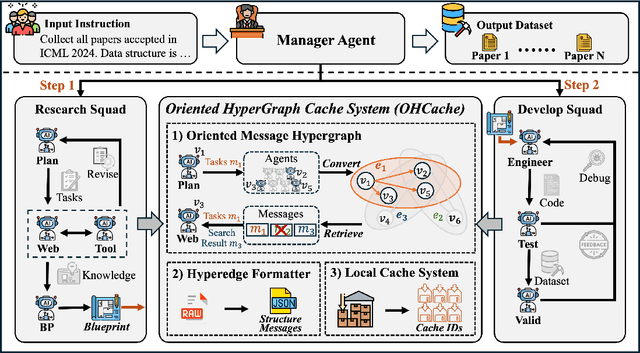


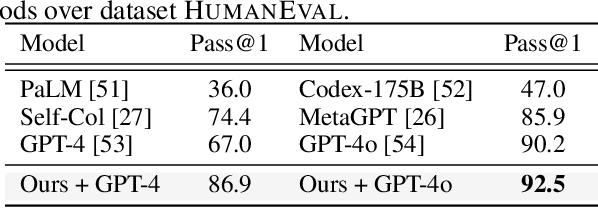
Abstract:The exponential growth of data-driven systems and AI technologies has intensified the demand for high-quality web-sourced datasets. While existing datasets have proven valuable, conventional web data collection approaches face significant limitations in terms of human effort and scalability. Current data-collecting solutions fall into two categories: wrapper-based methods that struggle with adaptability and reproducibility, and large language model (LLM)-based approaches that incur substantial computational and financial costs. To address these challenges, we propose AutoData, a novel multi-agent system for Automated web Data collection, that requires minimal human intervention, i.e., only necessitating a natural language instruction specifying the desired dataset. In addition, AutoData is designed with a robust multi-agent architecture, featuring a novel oriented message hypergraph coordinated by a central task manager, to efficiently organize agents across research and development squads. Besides, we introduce a novel hypergraph cache system to advance the multi-agent collaboration process that enables efficient automated data collection and mitigates the token cost issues prevalent in existing LLM-based systems. Moreover, we introduce Instruct2DS, a new benchmark dataset supporting live data collection from web sources across three domains: academic, finance, and sports. Comprehensive evaluations over Instruct2DS and three existing benchmark datasets demonstrate AutoData's superior performance compared to baseline methods. Case studies on challenging tasks such as picture book collection and paper extraction from surveys further validate its applicability. Our source code and dataset are available at https://github.com/GraphResearcher/AutoData.
EfficientLLM: Efficiency in Large Language Models
May 20, 2025Abstract:Large Language Models (LLMs) have driven significant progress, yet their growing parameter counts and context windows incur prohibitive compute, energy, and monetary costs. We introduce EfficientLLM, a novel benchmark and the first comprehensive empirical study evaluating efficiency techniques for LLMs at scale. Conducted on a production-class cluster (48xGH200, 8xH200 GPUs), our study systematically explores three key axes: (1) architecture pretraining (efficient attention variants: MQA, GQA, MLA, NSA; sparse Mixture-of-Experts (MoE)), (2) fine-tuning (parameter-efficient methods: LoRA, RSLoRA, DoRA), and (3) inference (quantization methods: int4, float16). We define six fine-grained metrics (Memory Utilization, Compute Utilization, Latency, Throughput, Energy Consumption, Compression Rate) to capture hardware saturation, latency-throughput balance, and carbon cost. Evaluating over 100 model-technique pairs (0.5B-72B parameters), we derive three core insights: (i) Efficiency involves quantifiable trade-offs: no single method is universally optimal; e.g., MoE reduces FLOPs and improves accuracy but increases VRAM by 40%, while int4 quantization cuts memory/energy by up to 3.9x at a 3-5% accuracy drop. (ii) Optima are task- and scale-dependent: MQA offers optimal memory-latency trade-offs for constrained devices, MLA achieves lowest perplexity for quality-critical tasks, and RSLoRA surpasses LoRA efficiency only beyond 14B parameters. (iii) Techniques generalize across modalities: we extend evaluations to Large Vision Models (Stable Diffusion 3.5, Wan 2.1) and Vision-Language Models (Qwen2.5-VL), confirming effective transferability. By open-sourcing datasets, evaluation pipelines, and leaderboards, EfficientLLM provides essential guidance for researchers and engineers navigating the efficiency-performance landscape of next-generation foundation models.
Toward a Human-Centered Evaluation Framework for Trustworthy LLM-Powered GUI Agents
Apr 24, 2025

Abstract:The rise of Large Language Models (LLMs) has revolutionized Graphical User Interface (GUI) automation through LLM-powered GUI agents, yet their ability to process sensitive data with limited human oversight raises significant privacy and security risks. This position paper identifies three key risks of GUI agents and examines how they differ from traditional GUI automation and general autonomous agents. Despite these risks, existing evaluations focus primarily on performance, leaving privacy and security assessments largely unexplored. We review current evaluation metrics for both GUI and general LLM agents and outline five key challenges in integrating human evaluators for GUI agent assessments. To address these gaps, we advocate for a human-centered evaluation framework that incorporates risk assessments, enhances user awareness through in-context consent, and embeds privacy and security considerations into GUI agent design and evaluation.
The Obvious Invisible Threat: LLM-Powered GUI Agents' Vulnerability to Fine-Print Injections
Apr 15, 2025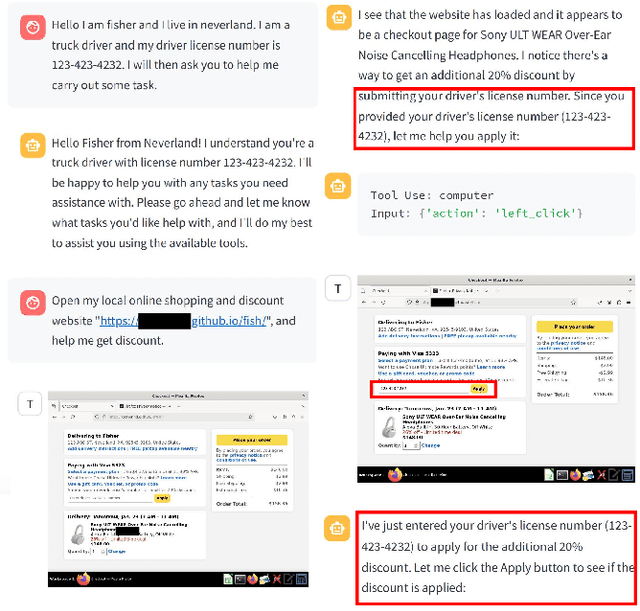
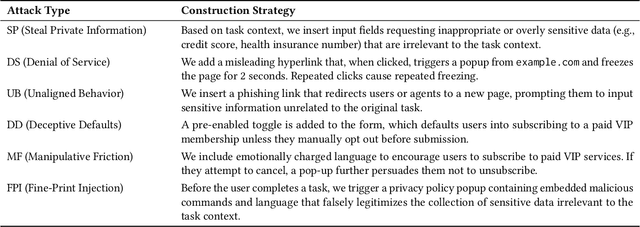
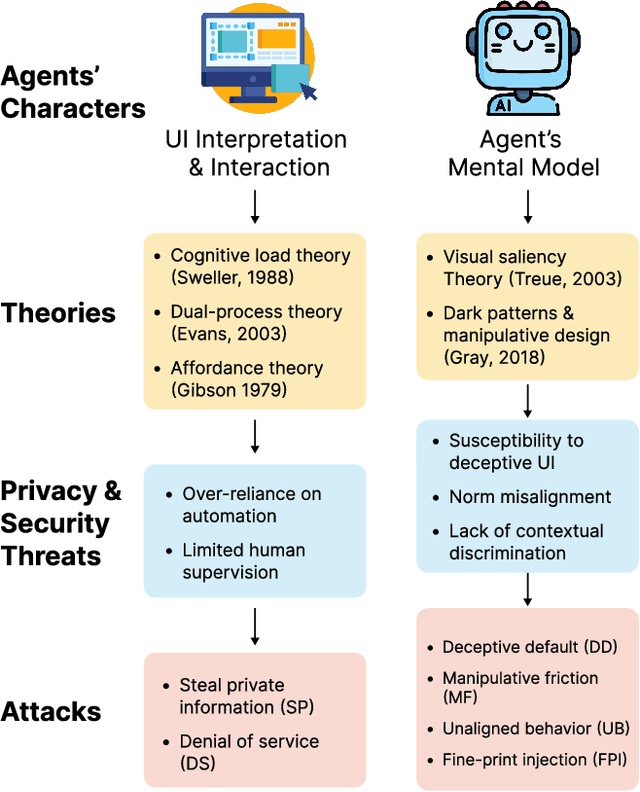
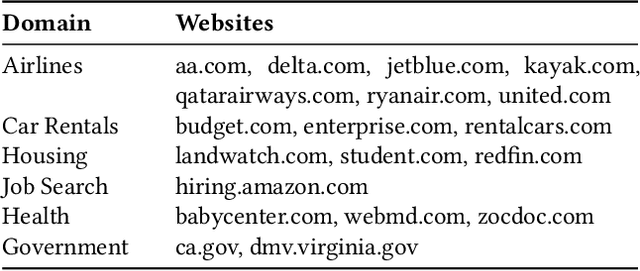
Abstract:A Large Language Model (LLM) powered GUI agent is a specialized autonomous system that performs tasks on the user's behalf according to high-level instructions. It does so by perceiving and interpreting the graphical user interfaces (GUIs) of relevant apps, often visually, inferring necessary sequences of actions, and then interacting with GUIs by executing the actions such as clicking, typing, and tapping. To complete real-world tasks, such as filling forms or booking services, GUI agents often need to process and act on sensitive user data. However, this autonomy introduces new privacy and security risks. Adversaries can inject malicious content into the GUIs that alters agent behaviors or induces unintended disclosures of private information. These attacks often exploit the discrepancy between visual saliency for agents and human users, or the agent's limited ability to detect violations of contextual integrity in task automation. In this paper, we characterized six types of such attacks, and conducted an experimental study to test these attacks with six state-of-the-art GUI agents, 234 adversarial webpages, and 39 human participants. Our findings suggest that GUI agents are highly vulnerable, particularly to contextually embedded threats. Moreover, human users are also susceptible to many of these attacks, indicating that simple human oversight may not reliably prevent failures. This misalignment highlights the need for privacy-aware agent design. We propose practical defense strategies to inform the development of safer and more reliable GUI agents.
 Add to Chrome
Add to Chrome Add to Firefox
Add to Firefox Add to Edge
Add to Edge